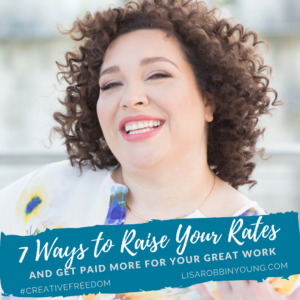 This is Season Four, Episode Six. This is the next logical step after our last episode. Once you get clear that it's time to raise your rates, how, exactly do you go about raising them? Have a listen to this week's episode, where I walk you through a few different approaches, from the basic, Nike approach (just DO it already!) to the "Tuna Can" approach and more. This is the fifth episode in a series about overcoming underearning.
This is Season Four, Episode Six. This is the next logical step after our last episode. Once you get clear that it's time to raise your rates, how, exactly do you go about raising them? Have a listen to this week's episode, where I walk you through a few different approaches, from the basic, Nike approach (just DO it already!) to the "Tuna Can" approach and more. This is the fifth episode in a series about overcoming underearning.
Speaking of which, my program Overcoming Underearning for Creative Entrepreneurs is now open. If you need support in owning the value you bring to the marketplace, and adjusting your prices accordingly join us! Students are already reporting positive results!
Download Season 4 Episode 6 | iTunes | Anchor | Stitcher
If you’re listening to just the podcast, you’re only getting about a third of the deal. Catch the Creative Freedom web series or join me on Facebook on Fridays at 5:30pm Central time for a LIVE Q&A about the week's topic.
4:22 - Several options to raise rates with existing clients
10:23 - 2 of the 4 big questions every offer needs to answer (and why it matters to your pricing)
14:26 - How one coach cut her content in half and doubled her rates, effectively quadrupling her hourly rate.
21:26 - DIY, DWY, DFY - and how I use these tiers in my own business
Not a member yet? It's free! Click here to join our Rising Tide to get email updates, transcripts, and bonus downloadables only available to members.
Mentioned in this episode:
Music: "Welcome to the Show" by Kevin MacLeod
Licensed under Creative Commons: By Attribution 3.0
This one’s all about the dolla billz, baby! Many creative entrepreneurs get emotional when it comes to price increases. So, what if there were an easy, external way to know that it’s time to raise your rates?
What if there were 11 ways?
Your wish is my command! Here are 11 external indicators that can help you determine if the time is right for a price increase in your creative business.
Need help communicating that price increase? Consider joining us for the Creative Freedom Guide To Overcoming Underearning, and build your confidence in changing your pricing!
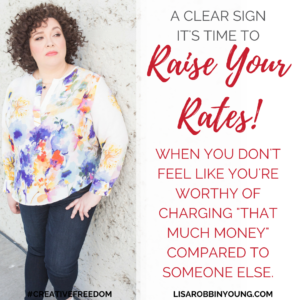 Share your thoughts and ideas in the comments. Your insights may spark a conversation that helps someone else!
Share your thoughts and ideas in the comments. Your insights may spark a conversation that helps someone else!
Mentioned in this episode:
If you haven't already downloaded this week's bonus content, you'll want to do that here. Not a member yet? It's free! When you register for email updates, you also get access to episode transcripts, worksheets, and other downloadables!
Fashion jewelry from Kerianne at FancyBargain.com. Tell her you saw her bling on Creative Freedom!
Music: "Welcome to the Show" by Kevin MacLeod
Licensed under Creative Commons: By Attribution 3.0
Are you being a doormat in your business?
Do you constantly put everyone else's needs ahead of your own?
If so, you're not alone. This week, we're focusing on one way to mitigate the 5 core symptoms of underearning: learning how to say "no" with class and authenticity. This is the third in a series of videos this summer about overcoming the cycle of underearning.
As a mom and recovering pleaser, I have struggled with this issue personally for YEARS. This week's episode shares some examples and word choices you can swipe to help you practice saying "no" with class and confidence before the moment strikes. I also share an important warning about the tricky way your "no" can turn into an unwanted "yes" or a straight-up lie if you're not careful.
Share your thoughts and ideas in the comments. Your insights may spark a conversation that helps someone else!
Mentioned in this episode:
If you haven't already accessed this week's bonus content, you'll want to do that here. Not a member yet? It's free! When you register for email updates, you also get access to episode transcripts, worksheets, and other downloadables!
Fashion jewelry from Kerianne at FancyBargain.com. Tell her you saw her bling on Creative Freedom!
Video clip/song: "Yes" by LMFAO
Music: "Welcome to the Show" by Kevin MacLeod
Licensed under Creative Commons: By Attribution 3.0
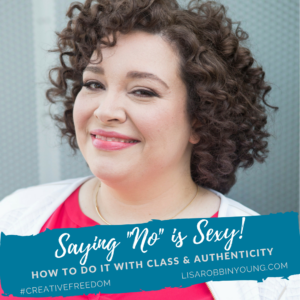 This is Season Four, Episode Four. Where we talk about how to say "no" with class and authenticity. Got someone who wants to pick your brain, ask you for a discount, or - GASP! - work for exposure? Need a classy way to say "um, no thanks!" without burning bridges or sounding like a jerk? You need this episode!
This is Season Four, Episode Four. Where we talk about how to say "no" with class and authenticity. Got someone who wants to pick your brain, ask you for a discount, or - GASP! - work for exposure? Need a classy way to say "um, no thanks!" without burning bridges or sounding like a jerk? You need this episode!
Being a doormat in your business sucks, quite frankly. It's also potentially a sign of co-dependence, which is one of our 5 Symptoms of Underearning. If you're saying yes to everyone and everything except yourself, it's time to re-wire your brain. Saying "no" is sexy, y'all, and today, I'm sharing tips to help you say it with class & authenticity. This is the third episode in a Summer-long series that deals with different aspects and triggers for underearning.
Need help with that whole "re-wiring" thang? Look no further than Overcoming Underearning for Creative Entrepreneurs. In just 5-weeks, you could build the clarity, confidence, and courage you need to finally beat the cycle of underearning once and for all. Plus, you get individualized email support throughout the program, so you're never alone in this journey.
Download Season 4 Episode 4 | iTunes | Anchor | Stitcher
If you’re listening to just the podcast, you’re only getting about a third of the deal. Catch the Creative Freedom web series or join me on Facebook on Fridays at 5:30pm Central time for a LIVE Q&A about the week's topic.
3:08 - The alternative to the vicious cycle of deadbeat clients and doing work you hate.
04:32 - The "Beef Stew" problem that shows up when you don't stand your ground and say "no".
9:00 - The importance of honoring boundaries
12:06 - What to say when someone is trying to talk you down on your rates
16:00 - The importance of saying "no" and trusting others to do their own work.
19:16 - The greatest lesson my Mom ever taught me.
24:03 - What happens when the desire to "not lose" ruins your plan to succeed (and how to fix it)
Still trying to decide what to say yes to, and what to say no to? There's an exercise in the Rising Tide this week for you to try.
Not a member? It's free! Click here to join our Rising Tide to get email updates, transcripts, and bonus downloadables only available to members.
Mentioned in this episode:
Music: "Welcome to the Show" by Kevin MacLeod
Licensed under Creative Commons: By Attribution 3.0
Every day, we're tasked with thousands of decisions.
How many? Well, Cornell University researchers said we make about 226 decisions just on FOOD in an average day.
The total number for adults is somewhere in the range of 35,000 decisions a day. Many of them are impulsive, and logic-driven (pro/con, etc.), but that's STILL a lot of remotely conscious decision making each and every day of your adult life.
Kids only make about 3000 decisions a day. Ahhh, those were simpler times, right?
Here's a decision making tool that I've used for myself and my clients for years now - one that gets immediate results and gives you clarity when you've probably been feeling stuck on something for a while, maybe even overwhelmed at the prospect of having to choose from several equally appealing (or unappealing, as the case may be) options.

This is just one of the tools you'll be working with in Your Breakout Year - my summer workshop for creative entrepreneurs. This program is designed to help you map out AND implement a clear path to a six-figure annual revenue stream.
THAT piece is the idea/concept/decision that holds the most energy for you, so that's where you need to act first (yes, even if you don't WANT to, which is another thing altogether).
The brain is a funny thing. When we take something out of one modality into another, our brain gets to work on the problem in a different way. By changing the way you assess the situation (from emotional or logical to visual), your brain has a new way of looking at the problem. The old block (which is probably a conflict between emotional and logical) is interrupted and you're able to make a decision so that you can move forward.
Often times, it doesn't matter what you decide, only that you finally make a decision so that you can get momentum again. So even if you "randomly" select a paper ball, you've made a decision and can move forward.
If you're a tactile processor, you might ACTUALLY write each option on a piece of paper and throw them on the floor. But then you've got a lot of cleaning up to do, which is totally NOT my jam. 🙂
Like I said, the messy room technique is is a powerful tool that's quick and easy to use to get clarity now, and get moving again.
Whether you're starting from scratch, been hobbling along at this for a while, or you're ready to expand and add a new revenue stream to your creative business, Your Breakout Year is the exact process I've used with clients - for over a decade now - to help them get clear on what really matters and build out a business model that gets them there faster, with less hustle, and more ease.
Courses and classes alone don't get the job done. You'll just end up with a lot of information and zero implementation. This is an implementation-heavy program because I believe that if you do the work, you'll get results. So doing the work is baked into the program. No "learn now, implement later" in Your Breakout Year. Implement as you learn, decide what works and what doesn't, cut the fluff, and see real financial results in your business.
There are still a few spots left for early bird pricing, and a 4 installment payment option to make it budget friendly.
If you're ready to find your right audience and make good money doing what you love without selling your soul, join me for Your Breakout Year.
We're slowly recovering from the rollover last week. My son's doing better this week, but we're still not out of the woods. Thanks for all the kind thoughts and well-wishes. It really did make the whole week seem better.
Through it all, thankfully, I still managed to get the important things in my life and work done. How? I learned a very simple way to prioritize my day so that what's really important gets handled. No. Matter. What.
About a year ago, I shared a brief overview of The PEACE System in one of the first season episodes. The one hurdle that people keep bringing to me is the never-ending to-do list. Despite prioritizing everything, there's a LOT of to-do's that still aren't getting done.
This week, we're digging into why.
Warning: you may be stepping on a few toes when you do, but never fear! The Spice Girls are here to help you!
Inside The PEACE System, I talk about three different kinds of to-do's. By paying attention to the different kinds of to-do's on your list, you can get a better handle on what is keeping you from getting more of the right things done.
Must-Do's are activities that must be done AND must be done by YOU, in order to reap the benefit. Generally, these are what I consider IPA - Important Personal Activities, or Income-Producing Activities. The definitions of those terms (like so many of the terms I use) are loose, and open to your interpretation. Brushing your teeth is a must-do. It's not likely you're going to get someone else to do it for you, and if you don't do it, well, there are consequences. Within the Must-Do category, there are a couple of types of Must-Do's - Routine/preventative (like brushing your teeth, seeing your kid's class play, or doing client work, for example), and Emergency (car roll-over, in-laws decided to drop in, that kind of thing).
The irony of many Emergency Must-Do's is that they are often (but not always) the result of NOT doing the Routine Must-Do's. If you don't get your tires checked on schedule, you could end up with a blowout on the freeway which causes the car to roll over - and the subsequent trip to the Emergency room. Do not skip the Routine stuff just because it's unsexy, or doesn't seem urgent. Preventative maintenance is crucial in your life and business!
Want To-Do's are all those activities related to the fun things we really want to do - like taking a trip (or planning it), visiting friends, working on a hobby, reading, watching a movie, etc. These aren't things that move the needle on our business, and they're not necessarily Must Do's, but we really want to do them. Chaotic and Fusion creatives tend to have a long list of Want To-Do's, which can lead to resentment, anger, frustration, and other disempowering emotions when you can't find the time to do those things. This typically results in an "all or nothing" rampage where work on everything else stops until you can clear some of the Want To-Do's off your list. Like the day I refused to do any work and just binge-watched my favorite show on Netflix all day. Not productive, but I sure did enjoy myself - until I started feeling guilty about not getting any work done.
Should-Do's are the bane of humanity. And I don't say that lightly. Everything from the well-meaning insinuations of your friends and family ("you should really finish packing for your trip, sweetie!"), to the more overt accusations we throw at ourselves ("I should really get to the gym this week!"), Should-Do's are the things that we throw into our day without making them a real priority. In the end, you may find yourself accomplishing a lot of Should-Do's, but not moving forward on your most important priorities at all. You sure are busy, but you're spinning your wheels on unimportant tasks - or worse, waffling from "should" to "should" - like bouncing back and forth between email and facebook messages for ten or fifteen minutes, just to be "sure" you're not missing anything important - and not getting anything accomplished at all.
Not that I speak from experience, or anything (sigh).
It's easy to get stuck in a "should-do" loop, and the only way to break the cycle is to make a decision. If it's a real priority, put it in your calendar and act on it appropriately. If you're not sure if it's a priority or not, try using the Eisenhower Matrix to help you get clarity. If it's not a priority, don't pretend like it is - even to appease your family or friends. In reality, you're doing a disservice to yourself and those well-meaning loved ones. Instead, set and enforce clear boundaries around your priorities and your time. And...
Be willing to accept the consequences of the priorities you set. (Tweet This)
Some people will balk at your new-found decisiveness. After all, you've been training them to give you all this well-meaning advice for a while now. It may take time to get them on board with this new direction. Your biggest fans, however, will understand that this is something you've got to do to take control of your calendar and start gaining momentum toward that Noble Empire and inspired life you're creating.
Share your thoughts and ideas in the comments, and let's be a rising tide fo everyone. If you're interested in learning more about The PEACE System, be sure to get on the wait list, as enrollment re-opens this fall.
After a LONG hiatus (longer than I wanted, truth be told, but whatever.), Creative Freedom is BACK!
Sound the trumpets, yo. This is a BIG deal for me.
As you'll see in today's episode, we've made some changes. Why? Because I have been changing. My life looks radically different than it did a couple of years ago, when Creative Freedom was only a glimmer in my eye.
I knew what I wanted to do, and I knew it would take time to make it happen. The only thing I wasn't sure of is whether or not I could actually pull it off... and if I did pull it off, I didn't know if I wanted to keep doing it.
Then, in the middle of all my planning and creating - to misquote John Lennon - life happened.
There's more to life and work than "the hustle." (Tweet This)
It took most of the last 12 months just to re-group and care for what was going on around me. And when I was ready to come out of my cocoon, it became more apparent than ever that Creative Freedom is not just a fun title for the show, it's the life I want to champion for other creative entrepreneurs.
How did I get there? Today's episode will give you some clarity around the three things I had to do in order to pull myself together and get my Noble Empire back on track.
I reached out to the members of my Accountability Club to share their genius on this topic as well:
How are you honoring the cycles of your creative life and Great Work? Share your thoughts and ideas in the comments and be part of our Rising Tide.
In my house, there's a never-ending battle that's almost as epic as the fight for the remote control.
The thermostat.
My husband likes it hot. He closes the vent in our room and bundles under at least two blankets even during Summer!
My son likes it cold. If it's warmer than 65, he'll turn the thermostat down to 50 because he thinks that'll make it colder faster.
Me? I like it in "the dead zone" - a comfortable 70-72 degrees. Not too hot, not too cold.
Needless to say, we've had a few arguments about this. In fact, hubby and I are finally switching sides of the bed this week because he's been sleeping closer to the vent (which is why he keeps closing it).
But...even more datstardly than our family fight for the house thermostat is the epic battle that's been going on between my ears for years with my metaphorical "success thermostat".
You may have heard it called an upper limit problem - that's a term Gay Hendricks used in his book "The Big Leap." Like a thermostat, our brains have a "success set-point" that keeps us comfortable. When we get too far below that set-point, we get uncomfortable, and start working to turn up the heat on our success. But I had a cap on what I believed I deserved. My "success ceiling" was a set-point that actually kept me earning poverty-level wages. No joke!
It was as if every time my money situation started improving, or things started going very well for me, invariably something would happen and things would start to fall apart. My success set-point kept trying to cool things off just as I was heating up!
In her book "Overcoming Underearning" Barbara Stanny says that "money is a metaphor" and that "under-earning is a symptom" - specifically a symptom of a lack of self-worth or self-love. It manifests differently for each person, but ultimately, it centers on a success ceiling/upper limit problem around what you think you deserve.
This week's episode of Creative Freedom revels how to know if you're a chronic under-earner, how I discovered my under-earning success ceiling, and how I've worked to eliminate my upper limit problem in my own life. Oh, and you'll hear bits of my U2/Journey mashup from the 300 songs project.
One look at the Symptoms of Underearning from Underearners Anonymous and you'll have a better idea of whether or not your current financial state is because of a conscious choice to live on less, a short-term slump, or a chronic condition that's due to something deeper.
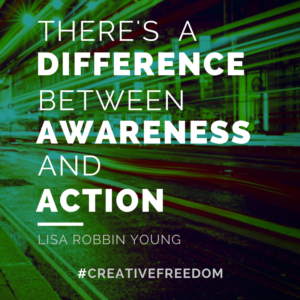
1. See the truth and OWN it. Just like a real thermostat setting, we have to make adjustments if we want to see things change. For most of us, we can't just "flip a switch" and solve the problem. Further, the "temperature" of our situation will most likely change gradually. You can't go from 32 degrees to 70 degrees in a matter of seconds - it takes time to turn up the heat! Decide on your new direction. What's going to change for you? Then commit to it, and be willing to make small (even microscopic) changes as you move toward your new set-point. The smaller the better actually. It might feel more tedious and time consuming, but micro-commitments are more likely to stick and lead to lasting change because they don't activate the fear centers in your brain. It's the fear center that triggers the thermostat to go back to what's "comfortable" - clearly a relative term when it comes to success.
2. Be wary of people who aren't used to your new settings. They will be uncomfortable (so will you). I have a colleague that says "new level, new devil". Remember what I've taught you before - you train people how to treat you based on what you've come to accept from tehm and what they've come to expect from you. Changing your success thermostat means you're changing the expectations. Some people won't like that - get used to it. It happens. The key is to recognize when people are trying to change your settings and stay the course even if things start to get a little (okay, a LOT) uncomfortable.
3. Believe you are worth it and stay vigilant! This is where all the micro commitments make a difference. Trying to re-program your brain to overcome years of unconscious programming ain't easy. When you've believed for decades that you're not capable of achieving a certain level of success, your brain may have difficulty accepting new ideas that seem to fly in the face of that old understanding. You need to keep looking for evidence for the file clerk in your head that says you are capable. Celebrate your wins even if they seem "small" or "insignificant" - the file clerk doesn't judge.
Eventually, the new set-point will feel comfortable. It takes time and patience, but it's totally doable.
Under-earning is one of the most prevalent problems of the creative community. From working for "exposure" to donating our time and offerings to way too many worthy causes, creative entrepreneurs need to reclaim their money making power! If you've overcome an upper-limit problem, we'd love to hear about it! Share your stories in the comments and be part of the Rising Tide community!
Sometimes it's innocent enough. Someone asks you to do something that's a real problem for them, but only takes you a quick second to handle. Once it's finished, they offer to compensate you in some way - maybe taking you to lunch, or actually offering you cash - but you decline.
I've done it more times than I care to count. Because I've got a pretty diverse background in all kinds of things, people ask me questions all the time. Sometimes it's a quick answer, other times, it requires a minute or two, but it's a whole lot easier for me than it is for them. They've just rented my brain (or my hands) for a project, and when they offered me compensation, I declined.
Whoops.
Whether it's your kids, your clients, your colleagues, or total strangers, you train people in every interaction you have with them. Last week, we talked about being too generous, and the other piece to that puzzle is turning away business/income/money because "it's no big deal" for you.
People come to expect you to be a certain way. My mom expected every McDonald's to have clean restrooms. Why? That's not part of their brand promise. Simply, mom had a lifetime of experience that gave her that expectation. The day she walked into a filthy McDonald's bathroom, she nearly blew her lid. Not because McDonald's ever promised her a clean restroom, but because she came to expect it because of all her past... um... interactions.
My grandfather was a carpenter and once charged a guy $50 to hang a picture frame on the wall. The guy was a bit miffed. "All you did was drive a nail!" When the guy asked him to itemize the bill, it looked like this:
Driving a nail: $5
Knowing where to drive the nail: $45
Total Due: $50
So often we discount the value of our hard-earned knowledge without even realizing it. Sure, it may only take a few minutes to handle that task for someone, but you've invested YEARS of learning how to do it in such a short time. There's value in that.
While my videos are meant to be fun, this is a serious issue for creatives - especially for women. My pal, Jason Stein, is super passionate about this topic and works with women entrepreneurs to help them deal with their money blocks. He's gifted at clearing the clutter and helping you see straight... and he's a bit of a badass, like me. And my friend and former coach, Teresa Romain, also takes a holistic approach to facing money issues. Both are incredibly gifted and compassionate folks that are good at untangling your money stories.
This week's episode of Creative Freedom talks more about this issue, as well as another way that we turn discount our value and turn away money or opportunities. Special thanks to my mastermind pals Pam and Jill for the impromptu jam session in today's episode!
You train people how to treat you based on what they expect & what you accept. (Tweet this.)
Are you expecting money to show up a certain way? Are you "not enoughing" the opportunities and money that you've already got? What other ways might you be "biting" or "hiding"?
Share your thoughts and ideas in the comments and let's be a rising tide for everyone. Remember to share this video with folks you know that could benefit. You'll have my undying gratitude for years to come!
First off: We're only a few weeks into our new web series, and I'm already getting questions and requests for topics to cover. YAY! If you've got a burning question you'd like to see me answer in the Creative Freedom series, let me know! We want to make this program as valuable as possible for you.
Now, on with the show!
It's a valid question. For me, there's a difference between being intentionally generous and being too generous - giving too much and coming across as desperate because of it. I've met plenty of direct sellers and other entrepreneurs who give not because they're being intentionally generous, but because they want potential clients to say "yes" - to validate them, affirm them, or just plain like them.
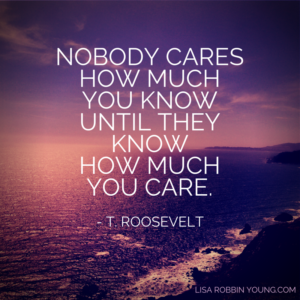
When you're intentionally generous, there's a solid strategy behind it (like giving 10% of all proceeds to charity, or to increase goodwill with existing customers), or you're feeling led by a divine call to be generous in a given situation. When you give from a place of fear or solely to be liked/affirmed, you're actually NOT being generous. You're being selfish (giving to get). True generosity comes when you're not expecting anything in return. True generosity has limits built in.
Piling on bonuses and giving lots of extra incentives hasn't worked in corporate America - quite the opposite, actually. The more you pile on, the worse the performance. Be intentional with your generosity.
Freebies, opt-in tools, and even your sales offers need to be strategic and focused. They're meant to help you clients get to know you, know what you have to offer, and trust that you are who you say you are (and that you provide the results you promise). Liking you is optional at this point. Remember what Teddy Roosevelt said: "Nobody cares what you know until they know that you care."
Who wants to be seen as the overgenerous desperate doormat? Train people how to treat you. (tweet this)
When it comes down to it, creating offers (and opt-ins) that are in alignment with your market isn't about over-giving. It's about establishing your relevance, building trust and credibility, and making it clear that you're the right person for the job. Likeability comes later. How have you created offers that work? Where did you stumble? What did you learn? Share your comments and insights and be part of our rising tide!